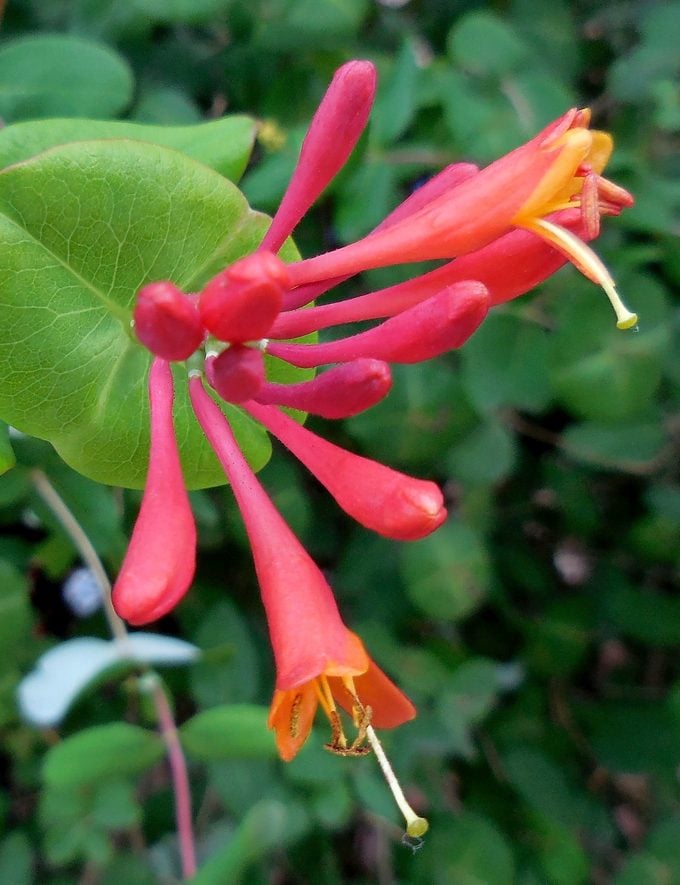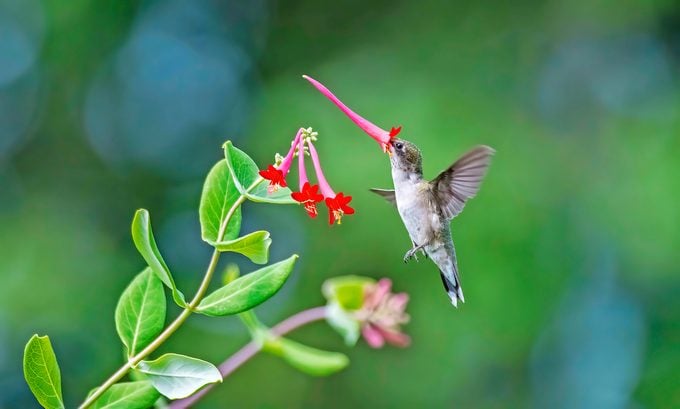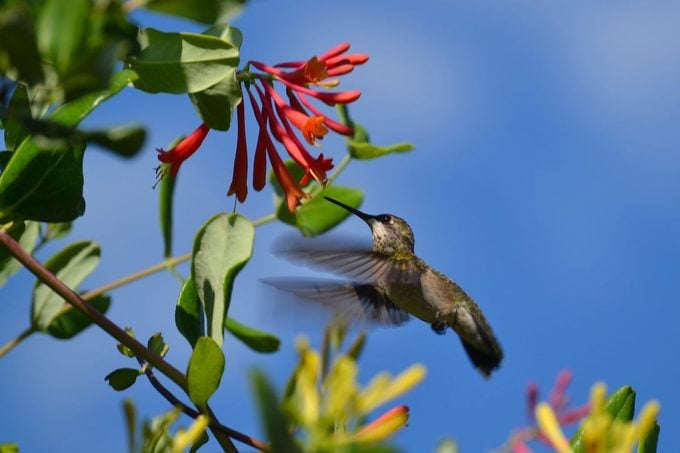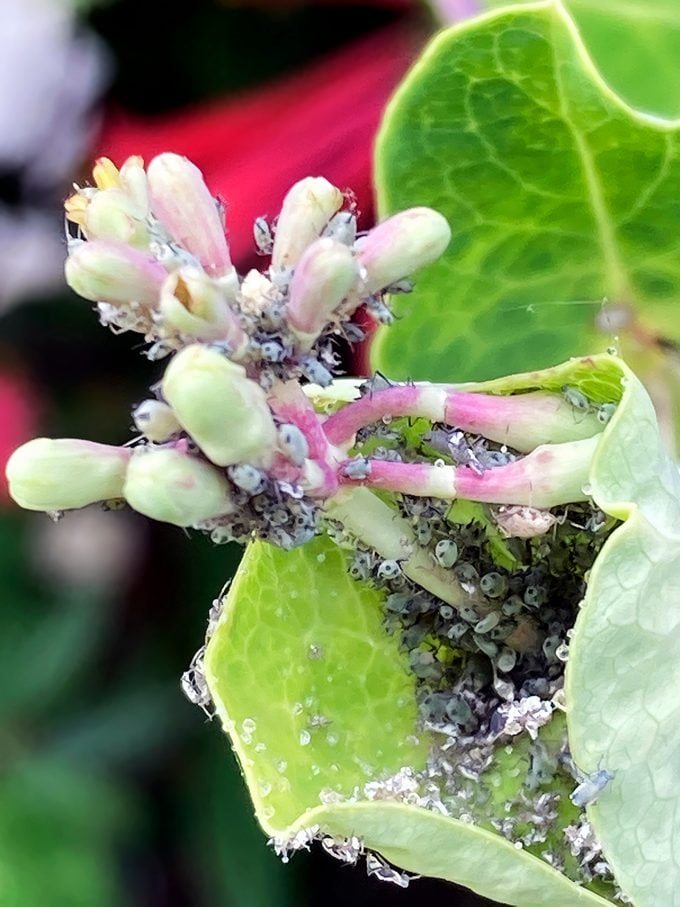Grow Trumpet Honeysuckle for Hummingbirds
Updated: Feb. 28, 2024
Get care and growing tips for trumpet honeysuckle, an red-flowering native vine that will bring hummingbirds to your garden in droves.
On This Page
Trumpet Honeysuckle Care and Growing Tips

- Botanical name: Lonicera sempervirens
- Common names: trumpet or coral honeysuckle
- Growing zones: 4a to 9b
- Native to: East Coast and Southeastern U.S., naturalized beyond
- Size: A vining plant with stems up to 20 feet, 3 to 6 feet wide
- Light needs: Full sun to partial shade
- Water needs: Medium
You can plant trumpet honeysuckle in spring or fall, in soil that is acidic to neutral. It prefers humus-rich, well-drained soil. Mary Phillips, head of Native Plant Habitat and Certification for the National Wildlife Federation, suggests top-dressing with compost at planting, and mulching. This honeysuckle prefers even moisture, so make sure to water during heat spells. You’ll see the best flower show in full sun, but it will still grow in partial shade.
“By providing a few key elements, you will keep this vining perennial happy for years to come,” says Lauren Carvalho, Horticulturist for High Country Gardens.
The main ingredients for success, she says, are providing well-drained soil and full sun.
As to maintenance, “Minimal pruning is required to keep your Lonicera looking nice,” Lauren says. “Remove dead or damaged branches and any unruly shoots that extend beyond your desired boundaries. Pro tip: L. sempervirens flowers on new growth so hold off on pruning until after the blooming period.”
Mary says she prunes her vine in late fall after blooming and thins it in early spring, mainly to keep it out of her pathway.
Check out the top 10 vines to grow for hummingbirds.
Wildlife Benefits

When swathed in scarlet red blooms beginning in late spring, hummingbirds find trumpet honeysuckle vine nearly irresistible. While not fragrant, this native vine is easy to grow and an abundant bloomer that supports a host of beneficial wildlife.
In addition to feeding hummingbirds and bees with its flowers, it’s a larval host to butterflies like the spring azure and supports quail and songbirds with red berries in the fall.
Mary says, “It’s native to the U.S. and that’s a benefit to our wildlife, and it’s widely available to consumers. Also, in milder climates it remains evergreen – I actually had blooms in February when it snowed (in Maryland).”
Grow more nectar-rich native plants for hummingbirds.
Trumpet Honeysuckle Cultivars

While there are several selections of the species on the market, including Major Wheeler, Blanche Sandman, Leo, and Magnifica, Mary grows the original and loves it.
“It’s been amazing to see all the hummingbirds come,” she says. “They flit all around hover come and go, it’s really beautiful.”
The most popular cultivar is ‘Major Wheeler,’ which High Country Gardens says has proven in trials to be the most profuse bloomer and was selected as the grower’s 2010 Plant of the Year.
What is the main difference between growing ‘Major Wheeler’ and the species? According to Growing Wild Nursery, if you want the berries to feed songbirds, you’ll have to plant a second, different selection of L. sempervirens to let the two plants cross-pollinate.
Among the species and selections, the long tubular flowers are typically shades of red, ranging from coral to scarlet, with yellow anthers. The leaves, typically evergreen in USDA Zones 8 and above, are an attractive blue-green color that beautifully complement the sunset-toned blooms. Trumpet honeysuckle usually begins blooming in late spring, which can be as early as March in the South, and continues intermittently through the growing season.
While choosing your plants, double-check the botanical name for L. sempervirens. Other honeysuckles are also called trumpet, like L. ciliosa, a Northwest native honeysuckle. If you buy trumpet vine, you’ll likely have a different species – Campsis radicans.
Is Trumpet Honeysuckle Invasive?
Many people wonder if L.sempervirens is as invasive as some other non-native species, like L. japonica, can be. Happily, trumpet honeysuckle is not considered invasive, but it does need plenty of room to grow.
Experts say it’s a versatile vine that is vigorous but not rampant. You can let it ramble as a ground cover. If you want it to climb, you’ll need a sturdy trellis or arbor to support it. The vines twine independently but will still need occasional tying in and trimming to look tidy.
Trumpet Honeysuckle Problems

While considered somewhat deer-resistant, Growing Wild Nursery suggests that if you live among deer, wrap the lower 5 feet of the plant with chicken wire to lessen browsing near the roots.
This native honeysuckle may occasionally be troubled by powdery mildew or aphids, says Lauren. Provide good air circulation in full sun, keep well-watered, and if aphids appear, hose them off.
Next, learn how to attract hummingbirds to a small garden.
About the Experts
Mary Phillips is head of Native Plant Habitat and Certification for the National Wildlife Federation. Since 2014, Mary has led Garden for Wildlife and Certified Wildlife Habitat programs as an ambassador for native plants.
Lauren Carvalho works as a horticultural manager for High Country Gardens. Lauren specializes in native pollinator plants and sustainable gardening practices.
Sources
- North Carolina Cooperative Extension – Lonicera sempervirens
- University of Connecticut – L. japonica
- United States Department of Agriculture – L. ciliosa
- Missouri Botanical Garden
- Growing Wild Nursery
Why Trust Us
For nearly 30 years, Birds & Blooms, a Trusted Media Brand, has been inspiring readers to have a lifelong love of birding, gardening and nature. We are the #1 bird and garden magazine in North America and a trusted online resource for over 15 million outdoor enthusiasts annually. Our library of thousands of informative articles and how-tos has been written by trusted journalists and fact-checked by bird and garden experts for accuracy. In addition to our staff of experienced gardeners and bird-watchers, we hire individuals who have years of education and hands-on experience with birding, bird feeding, gardening, butterflies, bugs and more. Learn more about Birds & Blooms, our field editor program, and our submission guidelines.




















